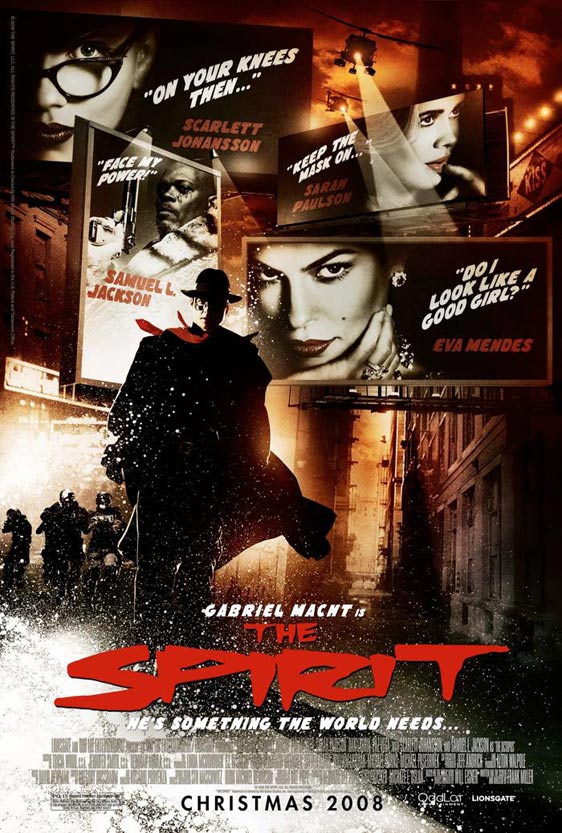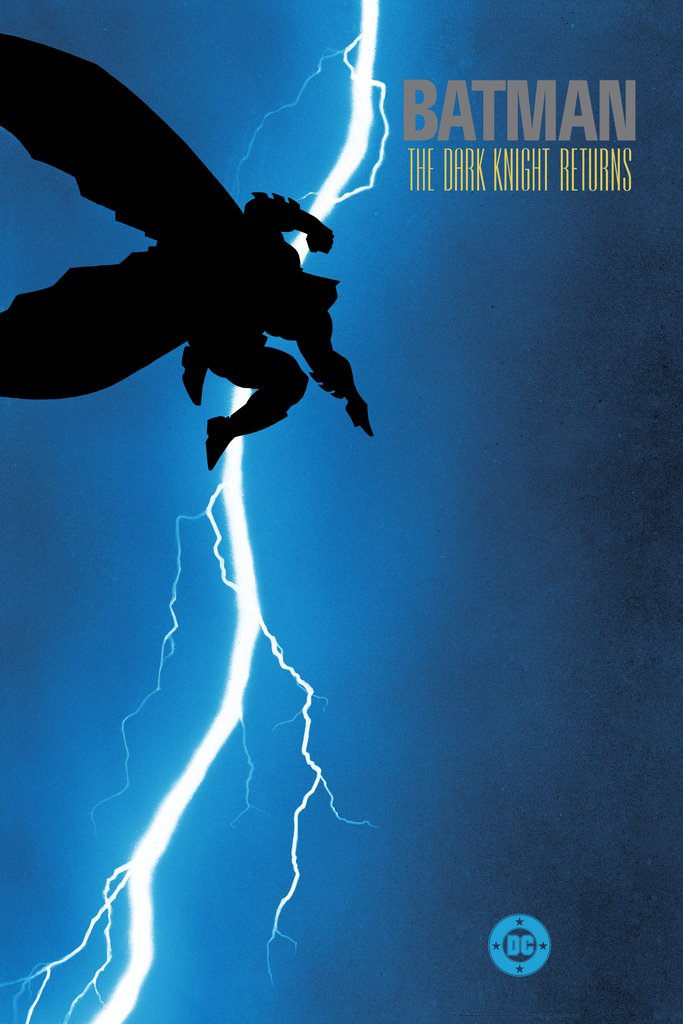 April of 2009 marked the DVD debut of writer/director FRANK MILLER’S film THE SPIRIT. I’ll refrain from reviewing this overdone and amateurish movie at length. Suffice it to say that if you’re among those who haven’t seen it (lucky you), then you can rest assured that it’s not really as bad as everyone claims—it’s worse!
April of 2009 marked the DVD debut of writer/director FRANK MILLER’S film THE SPIRIT. I’ll refrain from reviewing this overdone and amateurish movie at length. Suffice it to say that if you’re among those who haven’t seen it (lucky you), then you can rest assured that it’s not really as bad as everyone claims—it’s worse!
It’s also sadly representative of the downward arc Miller’s work has taken. Frank Miller, let’s not forget, was once among the absolute top names in the comic book field, both as a writer and illustrator. His masterpiece remains THE DARK KNIGHT RETURNS, the seminal 1986 comic miniseries that, together with Allan Moore’s WATCHMEN and several other seminal comics, changed the field forever.
THE DARK KNIGHT hasn’t held up as well as WATCHMEN, but remains a classic in its own right. Miller’s scripted prequel BATMAN: YEAR ONE isn’t quite as potent, while his 15-years-after-the-fact sequel THE DARK KNIGHT STRKIES AGAIN is an abomination, pure and simple (Miller also has a long-gestating Batman-vs.-Al Qaeda comic in the works, but who knows when that will be completed). Taken as a whole, these three works are sadly illustrative of Miller’s overall decline that took us from the heights of THE DARK KNIGHT RETURNS to the dregs of THE SPIRIT.
Here I’m going to take a look back at Miller’s dabbles in the world of Batman. Keep in mind that the following aren’t by a writer/illustrator who merely dabbled in the mythos, but one who irrevocably stamped it forever more.
Miller’s first-ever work in the Bat-verse was on WANTED: SANTA CLAUS—DEAD OR ALIVE, a ten page Batman comic from 1980 partially illustrated by Miller. Truth be told it’s not much, being a standard-issue quickie that sees the Dark Knight saving the life of a colleague on Christmas Eve. It is of interest, though, for a look at what Batman comics looked like before THE DARK KNIGHT RETURNS—because after its publication things just weren‘t the same.
The four-part DARK KNIGHT RETURNS was and is one of the seminal comic works of all time, a saga that, in the words of its creator, “gave Batman his  balls back.” It followed Miller’s nearly-as-groundbreaking RONIN (1983-4), a violent, adult-oriented saga of a time traveling samurai. Like RONIN, THE DARK KNIGHT eschewed the family-friendly tongue-in-cheek approach popular at the time, being an unapologetically R-rated effort that returned the Dark Knight to his shadowy origins as a near-psychotic avenger tormented by the murders of his parents.
balls back.” It followed Miller’s nearly-as-groundbreaking RONIN (1983-4), a violent, adult-oriented saga of a time traveling samurai. Like RONIN, THE DARK KNIGHT eschewed the family-friendly tongue-in-cheek approach popular at the time, being an unapologetically R-rated effort that returned the Dark Knight to his shadowy origins as a near-psychotic avenger tormented by the murders of his parents.
Miller, together with co-illustrator KLAUS JANSON and colorist LYNN VARLEY, created stunning graphics that remain unsurpassed for sheer eye-popping boldness. As a writer Miller takes care to weave in modern-day horrors like poverty and nuclear war, and even features appearances by Superman and Wonder Woman, giving them, along with the title character, appropriately mythic status, and making for a warped Superfriends redo–although the focus is always on the Dark Knight.
Again, DKR hasn’t held up as well as it might have, with a world view and central character on the level of a Dirty Harry movie (which makes sense, as DIRTY HARRY is reportedly a favorite of Miller’s). Yet the brilliance of the tale is undeniable. In an admiring introduction to the graphic novel edition of DKR, Alan Moore wrote that “Miller has managed to create something radiant which should hopefully illuminate things for the rest of the comic book field,” which it did indeed (although for the record, Moore wasn’t so enthusiastic about Miller’s subsequent efforts, dubbing his 1998 historical saga 300 “sublimely stupid”).
In 1986-7 Miller wrote a prequel to DKN, the 96-page BATMAN: YEAR ONE. Unfortunately Miller only did the scripting chores this time, and while the illustrations by DAVID MAZZUCCHELLI are solid, YEAR ONE suffers from the absence of Miller’s inimitable graphics.
The story, about Batman’s early years, isn’t all that inspiring either. It finds a young Bruce Wayne in a fight with corrupt cops where he meets up with a youthful Commissioner Gordon, here a lowly lieutenant, and so begins his crimefighting career. Catwoman also makes her first appearance, as does Harvey Dent, a.k.a. Two Face, and (on the final page) the Joker.
The ensuing years saw Miller create the award winning miniseries GIVE ME LIBERTY and its sequel MARTHA WASHINGTON GOES TO WAR, along with the three-part HARD-BOILED and the apparently never-ending SIN CITY saga (the movie adaptation of which marked Miller’s first stab at filmmaking). All are marked by ultra-violence, larger than life characterizations and an overall love of excess, which reached its apotheosis in 2001-2’s THE DARK KNIGHT STRIKES AGAIN, the long-in-coming sequel to DKR.
 Regarding this new Dark Knight adventure, it’s really, really bad. Related in a stream-of-consciousness manner (similar to that of Miller’s 1987 ELEKTRA ASSASSIN, a superior work in every respect), it has the Dark Knight getting resurrected (who knew he was dead?) to again fight crime in Gotham city, with everyone from Superman, Wonder Woman, Green Lantern and the original Robin turning up.
Regarding this new Dark Knight adventure, it’s really, really bad. Related in a stream-of-consciousness manner (similar to that of Miller’s 1987 ELEKTRA ASSASSIN, a superior work in every respect), it has the Dark Knight getting resurrected (who knew he was dead?) to again fight crime in Gotham city, with everyone from Superman, Wonder Woman, Green Lantern and the original Robin turning up.
What could have been a delirious romp ends up a dreary and confused muddle. There’s plenty of violence, but as drawn by Miller the male characters all look alike, so it’s difficult to make out who’s doing what to whom. There’s little in the way of characterization and no narrative to speak of; one scene has Batman beating the shit out of a bunch of corrupt politicians, but there’s no build-up to this violent act nor any sort of consequence. Quite a few promising concepts (i.e. an intriguing virtual reality angle that’s dropped far too quickly) are introduced but never properly developed.
Worst of all is the simple fact that there’s really nothing here that wasn’t already done in THE DARK KNIGHT RETURNS. As in that saga, the bulk of this one pivots on the rivalry between Batman and Superman, with Batman again proving himself superior. My advice? Read or reread THE DARK KNIGHT RETURNS and skip this disaster—and THE SPIRIT—at all costs.
